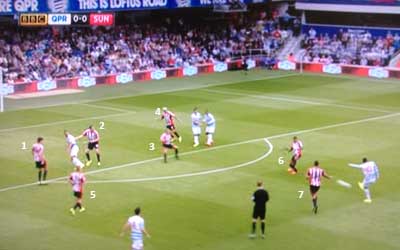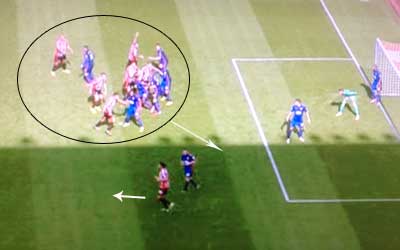After the international break, we return to Premier League action with a trip to Wearside for Sunderland vs Spurs at the Stadium of Light.
Gus Poyet pulled off a remarkable salvage job last season to steer the Black Cats to safety by imposing his stamp on the team.
Sunderland were very much a crossing side under both Martin O’Neill and Paulo Di Canio, but Poyet has completely gone the other way. He wants his team to be much more possession focussed and play with the ball at their feet.
So, what can we expect for our visit to the Stadium of Light and what should we be on the lookout for in Sunderland vs Spurs this season?
Where Sunderland concede chances
Right off the bat, the key to any game with the Black Cats during Poyet’s time in charge is linked to where and how aggressive you are in attacking them.
The Sunderland manager plays a counter attacking game, but the vital area has always been through the middle of their defence.
Gus Poyet has tested a number of things to stop this. Last season he tried a back three; this term he has his defence playing much narrower with Lee Cattermole as a screen.
This has seen them really crowd the central areas, as we can see from their last Premier League match against QPR.

Whilst this makes them tough to play through, if you attack them quickly enough, it can mean that their centre backs are pulled out in to wide areas.
Here, Wes Brown gets sucked out beyond full back Santiago Vergini in to an area he doesn’t want to be, leaving space for Junior Hoilett to exploit in the middle.

Getting in through these outside areas is now key to chance creation against them.
Antonio Valencia set up Man Utd’s goal in their 1-1 draw with Sunderland by getting in-behind Patrick van Aanholt to square for Juan Mata to prod home. Note the number of bodies in the centre leaving the full back 1v1 against Valencia.

Craig Gardner also set up West Brom’s go-ahead goal in their 2-2 draw with the Black Cats from getting in-behind in the right full back zone. Again, note the abundance of Red striped shirts in the middle, allowing Saido Berahino to peel off to the back post.

Two of the four goals Sunderland have conceded in the Premier League so far this season have come from teams getting down the edges. Interestingly the other two came from set pieces.
One was from the penalty spot as Victor Anichebe was fouled trying to get in through the middle. This Highlighted just how the Black Cats are trying to contain the centre, which used to be a porous area for them. The other goal they’ve conceded came from a corner against QPR, something we also struggled with against the Hoops.
The Tottenham tactics for Sunderland vs Spurs should focus on getting men out of the crowd in the centre and in to these wider areas to create chances.
How aggressive to be?
Whilst not getting sucked in to Sunderland heavily covering the centre, the other factor dictating this game will be how aggressive to be?
The Black Cats are a counter attacking team and like to engage the ball when it enters the middle third. Unless chasing a game, this will often see them let the opposition have it and then start to close down once the ball is played in to midfield.

This then has the effect of inviting the opposition on and having the choice of how aggressive they want to be as they will be susceptible to the counter attack.
So far this has seen Sunderland get caught in some stalemate matches as they have faced teams that have also been particularly non-aggressive.
In their first Premier League match they faced West Brom, who are also a counter attacking team and their game finished in a draw. Next up were Man Utd who have also adopted a similar system of only pressing once the ball has moved to the middle third since Louis van Gaal has taken over. Their third Premier League game saw them face QPR who are also quite reactive and scraped out their 1-0 winner from a set piece.
So far we’re yet to see a team play a high pressing game against them, which is what we’ve seen under Mauricio Pochettino. Our new coach has faced Poyet’s side three times, all at the Stadium of Light. His record doesn’t read well, having drawn once and lost twice.
A key example was the only drawn match, which finished Sunderland 2 Southampton 2, the only game of the three in the Premier League. Pochettino’s Saints raced in to a 2-0 lead with their high intensity game, then succumbed to the counter attack as the Black Cats netted twice.
Maybe Mauricio Pochettino needs to re-think how aggressively his team plays in Sunderland vs Spurs this weekend?
Sunderland creating chances
What’s more Sunderland’s counter attack through possession and passing sees them create chances with through balls.
I outlined at the top of the article how Poyet has switched Sunderland up from being a crossing team. Now the Black Cats are playing more consistently with a 4-3-3 and this sees them look to create chances on the break.
Poyet likes to use Steven Fletcher as a central striker, Conor Wickham as a wide forward from the left and either Adam Johnson or Will Buckley as a winger from the right.
Here against Man Utd we can see their 4-3-3 perfectly as Buckley creates a chance with a through ball for Wickham.

With Poyet employing a wide forward from the left in Wickham, he then asks his left back to be very attack minded. This sees Patrick van Aanholt often looking to get forward to support the attack.

The Dutchman has already created a goal for Sebastian Larsson on opening day against West Brom and continues to be a persistent threat on the overlap.
Of course, this can leave Sunderland’s left side open to being attacked, especially if Van Aanholt is caught forward, so this flank will be a key battleground.
Sunderland set pieces
A final area Gustavo Poyet has really worked on is set pieces. The Uruguayan was always good himself in these situations and he coaches his team well at them also.
This season, he has used a variety of routines with two themes.
The first has centred on spreading the six-yard box well with two players at the front post, two at the back post and two in the middle. The second is on bunch movement with miss-direction. These styles have been key in two of their Premier League three goals scored so far.
The first style was evident on their opening goal from a free-kick against West Brom. What this routine usually involves is a screen for a player to get open. Here we can see as the ball is delivered how John O’Shea screens the West Brom defender to block him off and get Wes Brown free.

Brown headed the ball back across goal and the partial clearance went straight to Lee Cattermole who rifled a shot in to the top corner of the net.
The second routine involves miss-direction. Against Man Utd we can see how a runner moves out from the edge of the six-yard box to take the defender away. This allows the bunch to move towards the open space and split. Jack Rodwell was lost in the crowd and had a free header to score.

Poyet has a lot of height at his disposal with Fletcher, Wickham, Rodwell, Vergini, O’Shea and Brown all good in the air. What’s more, both Sebastian Larsson and Adam Johnson can deliver good quality crosses to capitalise of their aerial strength.
Both routines are used on free kicks and corners, so the Tottenham tactics for Sunderland vs Spurs are a matter of knowing them and reacting to how they line-up at set pieces.
Sunderland vs Spurs outlook
We have a decent record at the Stadium of Light, winning our last two trips their 2-1. Unfortunately Mauricio Pochettino hasn’t enjoyed his trips their so much and is yet to beat Gus Poyet in three attempts.
We need to get at Sunderland down the outsides to avoid them overcrowding the centre, whilst also not over-committing to allow them in on the counter attack.
This will be a finely balanced game and could well be dictated by whoever scores first.
Sunderland vs Spurs prediction: Sunderland 1 Spurs 2.

So, in essence, you suggest Spurs should play the way Tim Sherwood did. I do not disagree!
Yes, sort of. Sherwood played with a number of different looks, but the way we detonated them 5-1 at the Lane can’t be overlooked. That night saw us get behind their wingbacks to cross and get a lead. After that, they were drawn out and we got between the lines to create havoc. This calls for something similar, but probably not with the 4-4-2 shape that Sherwood employed.